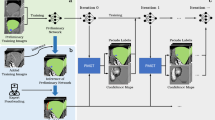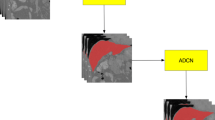Abstract
Segmentation of liver tumors plays an important role in the subsequent treatment of liver cancer. At present, the mainstream method is the fully supervised method based on deep learning, which requires medical experts to manually label a large number of pixel level labels for training, resulting in high time and labor cost. In this article, we focus on using bounding boxes as weak label to complete the segmentation task. It can be roughly divided into two steps. The first step is to use region mining technology to obtain pixel level labels from the bounding box. The second step uses pixel level labels to train the semantic segmentation network to obtain segmentation results. In the whole task, the quality of pixel level labels obtained from bounding boxes plays an important role in the performance of segmentation results. Therefore, our goal is to generate high-quality pixel level labels. Aiming at the problem that the current region mining method based on classification network is inaccurate and incomplete in object location, we use the Adversarial Complementary Learning module to make the network pay attention to more complete objects. We conduct analysis to validate the proposed method and show that our approach performs is comparable to that of the fully supervised method.
Access this chapter
Tax calculation will be finalised at checkout
Purchases are for personal use only
Similar content being viewed by others
References
Wild, C., Weiderpass, E., Stewart, B.W.: World Cancer Report: Cancer Research for Cancer Prevention. IARC Press (2020)
Long, J., Shelhamer, E., Darrell, T.: Fully convolutional networks for semantic segmentation. In: Proceedings of the IEEE Conference on Computer Vision and Pattern Recognition, pp. 3431–3440 (2015)
Papandreou, G., Chen, L.-C., Murphy, K.P., Yuille, A.L.: Weakly-and semi-supervised learning of a deep convolutional network for semantic image segmentation. In: Proceedings of the IEEE International Conference on Computer Vision, pp. 1742–1750 (2015)
Krähenbühl, P., Koltun, V.: Efficient inference in fully connected CRFs with Gaussian edge potentials. In: Advances in Neural Information Processing Systems, vol. 24 (2011)
Oh, Y., Kim, B., Ham, B.: Background-aware pooling and noise-aware loss for weakly-supervised semantic segmentation. In: Proceedings of the IEEE/CVF Conference on Computer Vision and Pattern Recognition, pp. 6913–6922 (2021)
Zhou, B., Khosla, A., Lapedriza, A., Oliva, A., Torralba, A.: Learning deep features for discriminative localization. In: Proceedings of the IEEE Conference on Computer Vision and Pattern Recognition, pp. 2921–2929 (2016)
Zhang, X., Wei, Y., Feng, J., Yang, Y., Huang, T.S.: Adversarial complementary learning for weakly supervised object localization. In: Proceedings of the IEEE Conference on Computer Vision and Pattern Recognition, pp. 1325–1334 (2018)
Lin, T.-Y., Dollár, P., Girshick, R., He, K., Hariharan, B., Belongie, S.: Feature pyramid networks for object detection. In: Proceedings of the IEEE Conference on Computer Vision and Pattern Recognition, pp. 2117–2125 (2017)
Khoreva, A., Benenson, R., Hosang, J., Hein, M., Schiele, B.: Simple does it: weakly supervised instance and semantic segmentation. In: Proceedings of the IEEE Conference on Computer Vision and Pattern Recognition, pp. 876–885 (2017)
He, K., Zhang, X., Ren, S., Sun, J.: Deep residual learning for image recognition. In: Proceedings of the IEEE Conference on Computer Vision and Pattern Recognition, pp. 770–778 (2016)
Chen, L.-C., Papandreou, G., Schroff, F., Adam, H.: Rethinking atrous convolution for semantic image segmentation. In: Conference on Computer Vision and Pattern Recognition (CVPR). IEEE/CVF (2017)
Milletari, F., Navab, N., Ahmadi, S.-A.: V-Net: fully convolutional neural networks for volumetric medical image segmentation. In: 2016 4th International Conference on 3D Vision (3DV), pp. 565–571. IEEE (2016)
Ronneberger, O., Fischer, P., Brox, T.: U-Net: convolutional networks for biomedical image segmentation. In: Navab, N., Hornegger, J., Wells, W.M., Frangi, A.F. (eds.) MICCAI 2015. LNCS, vol. 9351, pp. 234–241. Springer, Cham (2015). https://doi.org/10.1007/978-3-319-24574-4_28
Author information
Authors and Affiliations
Corresponding author
Editor information
Editors and Affiliations
Rights and permissions
Copyright information
© 2022 IFIP International Federation for Information Processing
About this paper
Cite this paper
Fan, M., Liu, H., Zhu, Z., Jiao, C., Gou, S. (2022). Weakly Supervised Liver Tumor Segmentation Based on Anchor Box and Adversarial Complementary Learning. In: Shi, Z., Jin, Y., Zhang, X. (eds) Intelligence Science IV. ICIS 2022. IFIP Advances in Information and Communication Technology, vol 659. Springer, Cham. https://doi.org/10.1007/978-3-031-14903-0_8
Download citation
DOI: https://doi.org/10.1007/978-3-031-14903-0_8
Published:
Publisher Name: Springer, Cham
Print ISBN: 978-3-031-14902-3
Online ISBN: 978-3-031-14903-0
eBook Packages: Computer ScienceComputer Science (R0)





